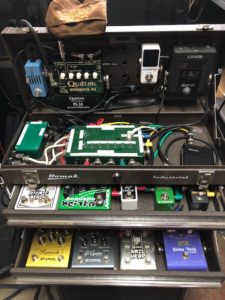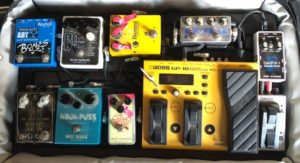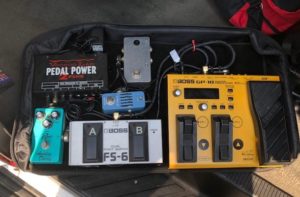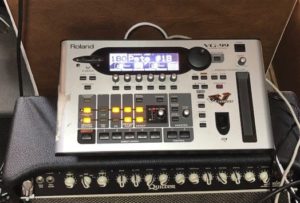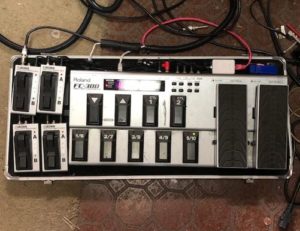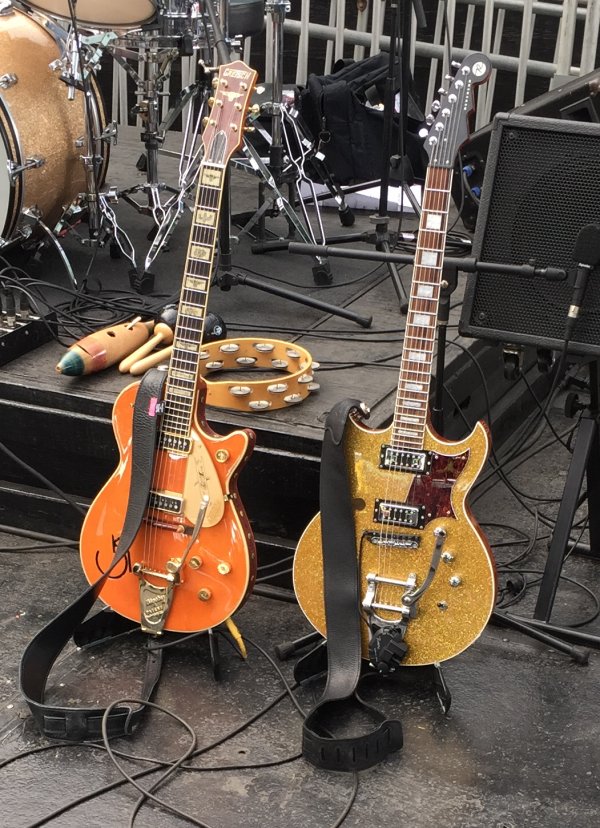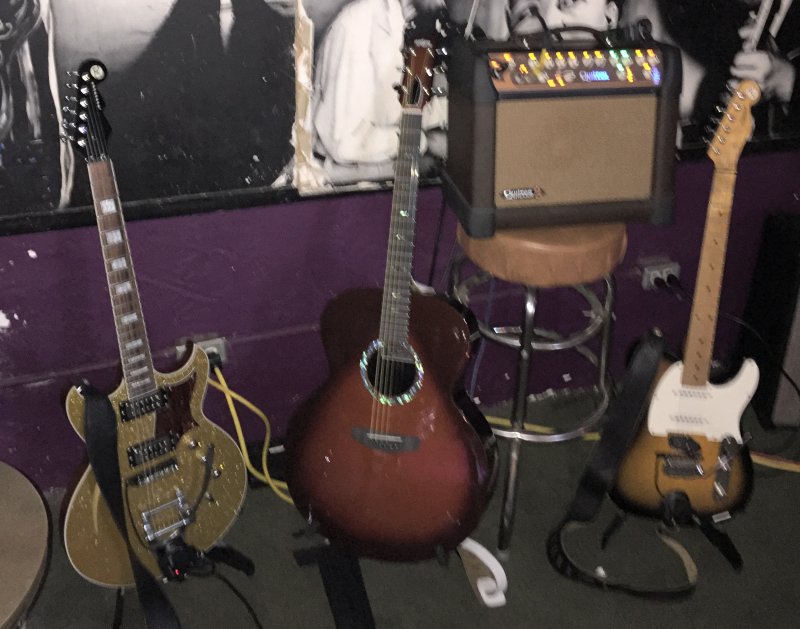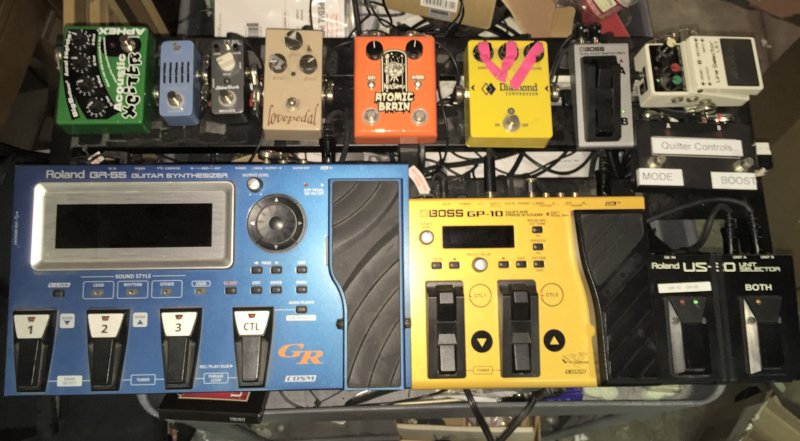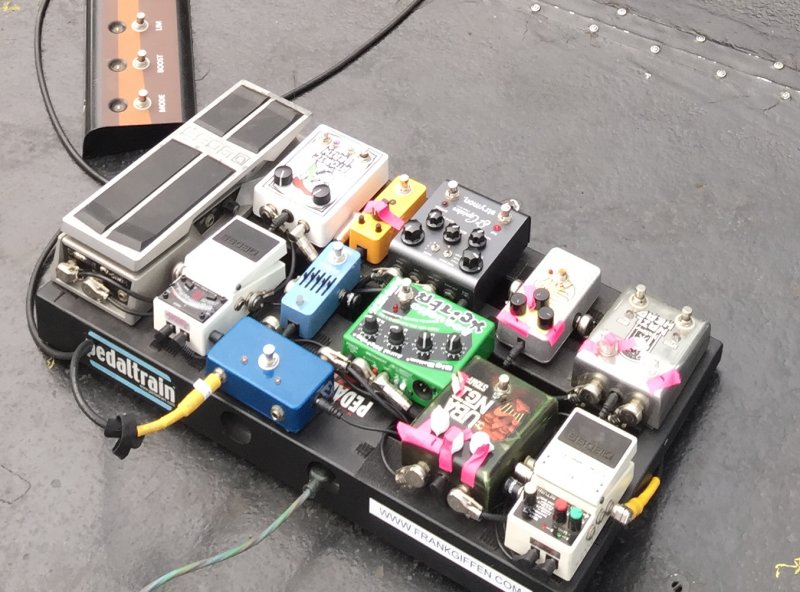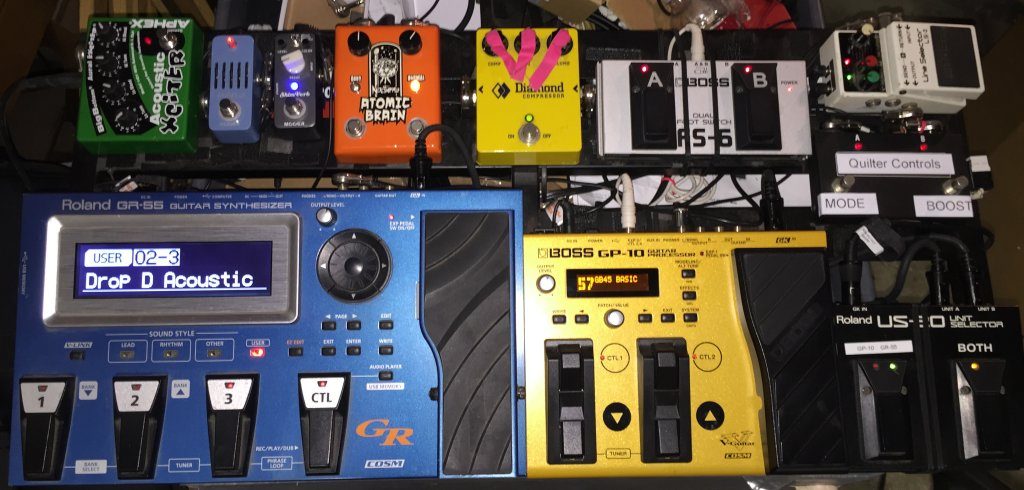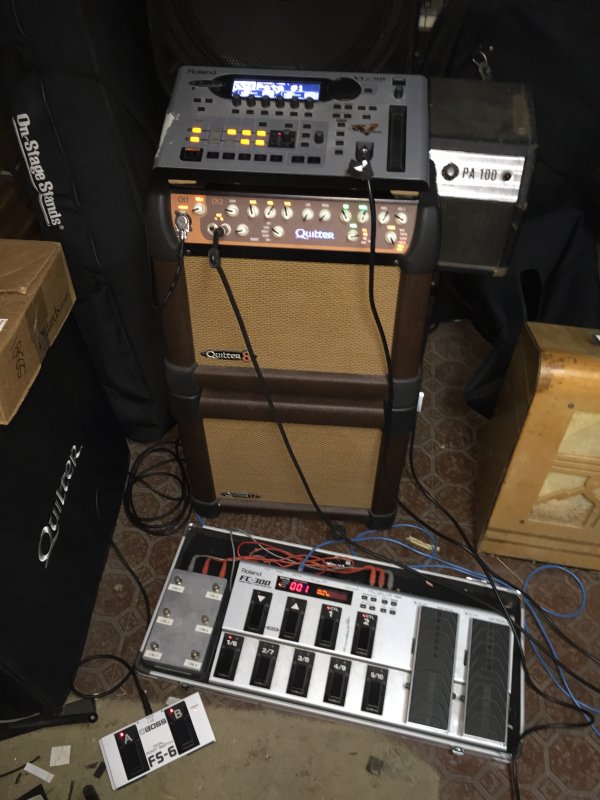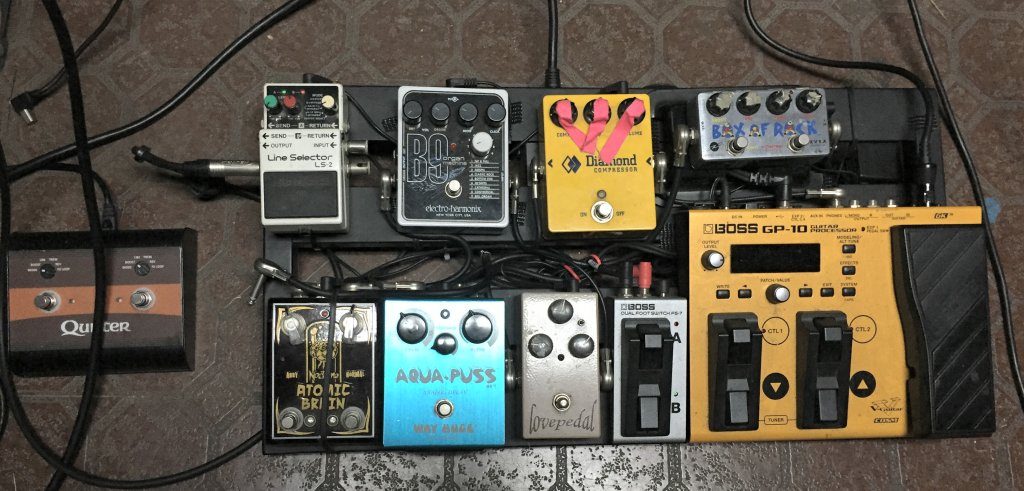Yes, I admit, I have GAS (Gear Acquisition Syndrome). It's a sickness, but it's kind of fun. My feeling is that when I'm sitting in the rocking chair at the old folks home, I would rather be able to say "Gibson Country Gentleman? I used to have one of those, I remember what they were like" than have to say "Gibson Country Gentleman? I remember those, I wonder what they were like...."
But the emphasis of this page is to talk about the gear I use and how and when I use it. So I'll talk about my guitars, amps, and pedals, probably to more of a degree than you want to read about. But hey, that's geekery for you. Thanks to Deke Dickerson for inventing (as far as I know) the term "geekery."
Guitars
Yes, I have a few guitars. The ones I like best, as far as electric ones go, are Gretsch and Reverend. And lately, thanks to some discussion with my friend Tavo Vega at thenocturnebrain.com, I've been quite enamored with the Nocturne Rooster guitar he had built just for me. On stage or in the studio, with the Lizards or with the country bands, I mainly use four different brands of guitars:
Nocturne - Tavo Vega has been making some absolutely killer pedals over the years. I should know, because I have most of them. But he recently started branching out into guitars, and the Nocturne Rooster he had made for me is quickly becoming my number one guitar for practically all gigs. Built by Barry at Grez Guitars, this guitar is as light as a feather, but easily provides the tone I've craved all these years. I'm proud to represent these guitars whenever I can.
Gretsch - I've been fond of Gretsch guitars for a long time (as you can see from the link on the home page, I was Gretsch Guitars' Player of the Month in March of 2022, an honor I'm still very proud of), and have had quite a few different ones, but with the Lizards, I mostly use either a Cadillac Green Country Club or an orange 6130 Roundup, equipped with TV Jones or Dynasonic pickups and Tru Arc bridges (aluminum and glass). Loving the big sound of that big guitar and the Brian Setzer Signature TV Jones pickups, or the Roundup with its stock Dynasonics to play a show with. A number of years ago, I did a demo video for TrueTone of the G6120CGP, the Chet Atkins model with no f-holes, a stereo pickup (bass strings on one channel , treble on the other), and a 1-3/4" nut. Then they made me a deal on it, and I had one for a while, and played it in the early days of my tenure with the Lizards. But I sold it, and somewhat recently thought that wider nut width seemed mighty appealing, but these were a limited edition model, and seldom come up for sale. Then about that time I saw Deke Dickerson post on Facebook, raving about a guitar shop in LaCrosse, WI called Dave's Guitar Shop. I said to myself, "If they're so great, they'd have a G6120CGP for sale," and on a lark, I looked. And whaddya know, they did. The key word there is "did," because I bought it, and while I bought it to play with the Lizards, I brought it to rehearsal with The Esquires, and I've brought every hollowbody I own to rehearsal there, but the Director said he likes the sound of the CGP the best, so that's where it gets the most play.
Reverend - I have one of the prototypes of the Pete Anderson Eastsider S model, and it's my #1, go-to, country-twangin', Tele-like object (I have 4 other versions of the Eastsider, too, including the baritone). I've also got a Tricky Gomez RT semi-hollow which gives the Eastsider some competition for the #1 spot lately. It's a versatile, Bigsby-equipped beauty that is a treat to play. It's also my backup axe with the Leapin' Lizards. I've got all 4 different flavors of the Pete Anderson hollowbody, which are some of the most versatile and greatest-sounding guitars on the market. They can serve with any band I play with. If I'm in doubt about what guitar I'll need for a job, I bring one of the PA models and I can get the tone I need pretty easily. Much more recently, I got a Contender RB in a metallic green they call "Outfield Ivy," and it carries on the great-sounding coolness that is rapidly becoming Reverend's tradition. Its new RetroBlaster pickups are fine, indeed. The RetroBlasters work well in the PA-1RB, too.
And not long ago I started playing bass, so of course I went Rev. I have a Dub King that covers all the, er, basses. For a while I had a Mercalli 5, which was great, but I sold it because I wasn't getting many bass gigs. Then I saw Ibanez made a short-scale Talman 5-string bass, and that just seemed like it would be perfect for me, and I have concluded it is.
RainSong - Much as I love Martins, Guilds, and well-made Gibsons, for acoustic guitar duty in any band, I don't think you can beat a RainSong. They stay in tune, don't care about temperature or humidity changes, and they're pretty much indestructible. I've got a WS-1000 that has 22 years and a whole lot of miles on it, but still looks like new. It's the guitar you hear on the acoustic song ("Believe") on the Lizards' "Spin Me" album. The case has seen better days, but that's why we have cases, right?
I also think a lot of Eastman Guitars. I've owned about a half-dozen of them, and right now, the only one I have is an AR-804 all-solid-wood archtop with an oval soundhole (I've always had a soft spot in my heart for oval-soundhole archtops), and this one is a prime example. But wait, there's more! I used to have a Martin Custom Shop that was essentially a JC-40, and I kick myself daily for letting it go. But a year or so ago I found a JC-16RE Aura that was almost the same specs, with the Fishman Aura pickup system, and got it from a great guy at a great price, and I've been gigging with it a lot on acoustic gigs. And I manage to combine my affection for guitar synths with acousticity (is that a word? I guess it is now), using Godin Multiac guitars. My first was a Multiac Nylon SA, which I bought from another great guy, he and I have never actually met, but he's a very talented musician and great family man, Omar, and the guy I bought the Martin from, John Henry, are the only two guys I've ever bought guitars from and then become Facebook friends with, and it seems right, because I like these guys, and I love the guitars they sold me. Anyway, the Multiac is a solidbody, bolt-on neck nylon string guitar, and even though it's a solidbody and needs to be played amplified, the solid spruce top and the RMC pickup system give it just the right amount of snap for the nylon sound I like. Godin doesn't make a steel-string version with synth access anymore, but I found an older model Multiac Steel SA for sale at Elderly a while back, and after some electronic repair and a great setup by Eric's Guitar Shop, it plays like a dream. The older pickup system doesn't sound quite as good as the one in the Nylon, but it's a fine stage acoustic that doesn't feed back like a lot of acoustics, thanks to it's solidbody, non-soundhole design. I really should play it out more often.
Want to see some guitars I've let slip away (some for good reason, some with big regrets)? Click here for the Ones That Got Away. This is an incomplete list, and some of the picture links don't work, thanks to a couple of web server migrations that didn't go as planned. Many more have come and gone since I had the patience to create that page.
Strings
Asking people who makes the best strings is like asking who makes the best pizza. Everybody has an opinion, and it's usually different from everyone else's. I played Elixir strings for a long time, and that's their advantage, you can play them for a long time before you have to change them. But my current favorites on electric guitars come from GHS. My buddies at TrueTone Music in Santa Monica turned me on to the Burnished Nickel Rockers electric strings, and they've got the tone I need, their slight burnish makes them comfortable to play, and they sound consistently good through their life. And compared to Elixirs, they're a bargain. My favorite story about these is when I went into Guitar Center looking for them and when I asked, the salesdude responded confusedly, "Barnacled strings? No, we don't have those." Just the thought of strings with barnacles on them makes my left-hand fingers hurt. The TrueTonians also recently turned me on to Thomastik Blues Sliders. I like Thomastik strings a lot. They're expensive, but they last forever and sound consistent. I have their Swing Lights on my Eastman AR-372, and the 10-49 Blues Sliders on a lot of my guitars. They bend well, but still have enough "fight" to them so you can hit 'em hard without their getting flabby.
Acoustically, I've got several acoustics with soundhole magnetic pickups, and GHS White Bronze drive those pickups better and more evenly than any other acoustic string, and I've been using them for years. I also like Martin's Retro strings, and have them on my 1939 Gibson ES-150 (with the Charlie Christian pickup) and they make that guitar sound like the vintage ax that it is. I also put them on my Eastman AR-804. They make a lot of different bronze and phosphor bronze strings, too, and I'm still trying their different flavors to see which ones my guitars like. As Tommy Emmanuel says, "Your guitar may like different strings from what you do," so since my guitars have to wear them, I'll see what they like best.
Amps
For amps, I like a couple of brands:
Quilter -- Quilters are the perfect amp for the gigging musician. They're lightweight, great-sounding, durable, and they're also made right here in Southern California. I like to mix and match speaker cabinets with my MicroPro head, but I can play an outdoor gig wth my 19-pound MicroPro-8 and be plenty loud, even un-mic'd. And the 8 makes a great acoustic guitar amp, too. I had the Steelaire (sold it to help pay for a bicycle; the trouble with having multiple hobbies, and while it's a great amp, no regrets because I love the Aethos it helped fund), with its 15" speaker, a Tone Block, an Overdrive 200, a Pro Block, a Micro Block, two InterBlocks (for stereo), a SuperBlock US, and my current obsession, a Mach 3. I run the SuperBlock either into a couple of cabinets, or the DI goes into a Pro Block and out through a Frontliner 2x8 cab, a combination that can melt faces with volume. And for bass, I recently picked up a Quilter Bass Block 802 and a 12" Bass Block Dock cabinet, along wth a 10" Block Dock. 800 watts of low-frequency heaven, I liked it so much I sold my Aguilar rig, and I liked that Aguilar a lot.
Fender -- You can't really play guitar in Southern California and not have some experience with Fenders. And I've had a Deluxe Reverb, a Twin Reverb, a Bassman, a Bassman 50, a 75, a Steel King, a Vibrosonic, a Twin Reverb Custom 15, and even an Amp Can, but right now, the one Fender I've got left is a PA-100 head which has been modded so each of the 4 channels has a slightly different voice, 1 stock, 1 blackface, 1 higher-gain, and one I-don't-know-what-it-is, but they all sound great, and I've got plenty of different cabs to play them through.
Victoria -- I've had a couple Victorias over the years, and I always enjoyed trying out guitars through them at TrueTone. Victoria made the short-lived Gretsch Executive, Variety, and Playboy models a few years back, and they were sweet. I had an Executive briefly. And by coincidence, I met Mark Baier, the owner of Victoria, at a NAMM soiree a few years back and he offered to build me another amp just like the Gretsch. But I recently mentioned on Facebook that I missed having that Gretsch Executive, and wouldn't you know it, my friend Don Birchett saw that and offered to sell me his. Even though I was without a day job at the time, I jumped at the chance and drove out to Arizona one day to pick it up. And am I glad I did.
Cave Valley Amps -- A friend named Ethan whom I met at a Gretsch Roundup builds amps called Cave Valley Amps. He not only builds the amps, he makes all the cabinets by hand, and they're beautiful. I, well, my wife actually won it, but she gave me custody, won a small one called the Super 8, an 8-watt, Gretschy-looking practice amp, in a raffle, and while it's only loud enough to practice with, it's a fine-sounding little amp. A couple years later, he made me an offer I couldn't refuse on a larger, 18-watt combo called the Kharma 18. Its 12" speaker can crank and it's a great amp to gig with. And it plays very well with pedals.
Pedals
Pedals and processors are a big topic with me, mainly because I have a lot of them, and use some extensively.
One thing that's common to all my rigs is the Nocturne Atomic Brain. It's a preamp that duplicates the preamp of the Roland RE-301 Space Echo, made famous by Brian Setzer. These, and other, pedals are made by Tavo Vega, a rockabilly wild-man who builds pedals for rockabilly musicians, but his pedals are great for lots of different kinds of music. He's another Southern California boy, way down San Diego way.
I used to use a separate pedalboard for the Leapin' Lizards, and it had an Atomic Brain, a Nocturne Nailhead tremolo, and a Nocturne Ubangi Stomp overdrive. It's also got a Strymon El Capistan delay, an unmodded EH Soul Food overdrive, a Mooer EQ (mostly used as an extra boost, though I currently have it set with the low end turned way down to get that sitar-ish sound in Wanda Jackson's "Funnel of Love," which is on our set list a lot), an Xotic SP compressor (shhh, don't tell the Rockabilly Police), a Boss TU-3 tuner, a Boss volume pedal, a Boss LS-2 line selector (for signal routing), and an Aphex Acousic Exciter, which is one of my tone secrets, and also provides a low-impedance DI if I need it. There's also a signal router I built that I call the "X-Box" that facilitates switching between two guitars without having to plug or unplug cables, or bypassing the pedal chain altogether and going straight to the amp (if I ever wanted to do that). This picture is a little out of date, at the urging of Ag Donnaloia, guitar player for the Johnny Boyd Band, I got an Xotic SP compressor to replace the Mooer. I like it a lot better. The compression is much more subtle, and the tone is great.
But that pedalboard took up a lot of room on stage. So I started thinking about how to resolve that, and it went on to become the Rackabilly. Click the link to learn its long and sordid history. Teaser: there's a suitably-attired outboard reverb tank project I'm working on that will be shown here soon.
The next one is what I call the Cowboy Board. I use it most with country bands like Haywire, Sterling Sylver, and even Randy Beckett once in a while. It's got a Boss GP-10 guitar and amp modeler, along with a Nocturne Mystery Brain, a ZVex Box o' Rock, the Xotic SP compressor (the Diamond got shoehorned into the Rackabilly), an EH B9 organ pedal (for that intro to "Fast As You," and a Radial ABY switch so I can send to either or both of the channels in my Quilter Mach II, Steelaire, or 2 of the channels on the PA-100. The GP-10 enables me to switch from acoustic to electric and back again, in different tunings, 6 or 12 strings, etc., on the fly, which I need to be able to do in the country bands I play in these days. This board undergoes changes now and again when I get curious or inspired. This photo is not up to date.
Next, there's the Backup Board. It's got a second GP-10, an EQ, a Rogue delay pedal (the same cheap one Ashley Kingman uses with Big Sandy; his rationale: "it's not bad, and if it gets nicked, I'm not out too many quid"). It doesn't see much use (it goes to every gig, but seldom comes out of the van), but if I need to travel light, it's a good grab-and-go that'll cover most everything. This board, too, has been updated and needs a new photo. Offhand, I don't remember all I've done to it.
Finally, there's what I have traditionally called The Nuclear Powered Stompbox. The Roland VG-99 was the apex of guitar/amp/effects modeling in its day, with unprecedented and still unmatched flexibility. Roland humbly called it "The Future of Guitar." And it coulda been, but the market said otherwise. I, personally, embraced it and love it. I use a Roland FC-300, along with 4, count 'em 4, Boss FS-7 dual footswitches to control stuff. It didn't hurt that I had a friend who worked for Roland who could get me stuff for less than wholesale, but it was still a great piece of gear. And when Roland stopped making them, I was sad. When they stopped repairing them, I bought a second one, then in a moment of fiscal conservatism a while later, sold it at a hefty profit. But I'm going to continue to take care of mine, and hope it lasts a long, long time, because it can do everything I need it to, though admittedly, the acoustic models in the GP-10 sound better.
UPDATE: The VG-99 has been incorporated into my latest monstosity of a contraption, which I call Count Rackula. Yes, I've gone back to the '80s and built a rack system. I'll have to add some pictures of that soon.
Finally, there's the Virtual Board. It runs Bias FX for iOS on my iPad and feeds into a Quilter InterBlock. All I need is a speaker cabinet. I can even control it wirelessly with the FC-300. Pictures will come sometime soon.
And for jazz gigs, I just use the Quilter MicroPro and a cable. Still looking for the right size/thickness of a blanket to throw over the amp to get true modern jazz tone :).
ANOTHER UPDATE: I never mentioned the Count Rackula rolling rack system I put together. I have that written up somewhere (maybe it's in my blog, I don't recall), and should put it here.
YET ANOTHER UPDATE: Count Rackula was fun and effective, but it was a lot to cart around, and wouldn't fit on some stages. And I was worried the VG-99 might break, so I retired it and replaced it with Boss' SY-1000. That was a great decision, and I made my rig modular so if I don't need the GR-55 sounds, I can play without it with no modifications. I think I documented the new rig (haven't come up with a witty nickname for it yet) somewhere, so I should find that and put it here. One day I will, but I did do a video of it, so there's that. Gotta go get ready for a gig today. See ya!
Other Gear
Oh, we'll talk all about PA gear in the near future. (UPDATE: Glad I didn't spend any time on this, because it's all changed since I wrote that).
